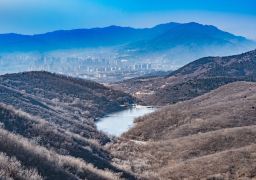It is said that in the prosperous Tang Dynasty, Chengsan was once a must-stop on the Zhejiang-Tang Poetry Road in eastern Zhejiang. In addition, many famous literati and refined scholars throughout history, such as poets Luo Binwang and Song Zhiwen, specially visited and toured here. So far, many masterpieces handed down through the ages have been recorded in the ‘Ode to Chengsan by Famous People of All Ages’ and are engraved on steles for circulation.
The stone pavilion of the Ming Dynasty is located at the southern foot of Chengsan Mountain. It is a protection pavilion for the tombstone of Zhang Gong, the assistant minister of the Taipu Temple in the Ming Dynasty. It was built in 1489, the second year of Hongzhi in the Ming Dynasty. It is made entirely of stone, with a height of 4.1 meters and a width of 2.3 meters. The four corners are slightly upturned and square with rounded corners. There are carved stone railings 0.55 meters high on both sides in front of the pavilion. In the pavilion, a stone tortoise carries a stone tablet with an epitaph engraved on it. It is basically well-preserved. In ancient times, there were three temples, six shrines and seventy-two nunneries. Among them, the somewhat famous one is the ‘Chenxin Temple’, also known as Chenxin Zide Temple and Chenxin Mountain Temple. It is located at the foot of Chengsan Mountain and was built in 637 AD. It was once extremely magnificent and glorious. This temple was still quite large-scale until the Qing Dynasty. It was on a par with Yunmen Temple and Fahua Temple and was somewhat famous in the Jiangnan area. It is a good place for people from near and far to burn incense and worship Buddha and for tourists to visit. Now, in Jinshan Temple in Jiangsu, the maps and spectra of Jishan and Chengsan, famous scenic spots in Daoxu, and the precious poems written by Tang Luo Binwang, Li Bai and others after they visited Chengsan in Daoxu are still well-preserved. After the temple was demolished after liberation, the current ‘Chenxin Temple’ is newly built by villagers raising funds and choosing a location. The Immortal Aunt Cave is located on the east side of Immortal Aunt Peak. According to the inscription on the Immortal Aunt Hall stele, it is said that at the end of the Spring and Autumn Period, Bao Liugu, a woman from Tiantai, and her sister-in-law floated on the river and drifted to Chengsan Mountain. They lived in a cave and practiced swordsmanship and helped the King of Yue to forge swords and succeeded. The king ordered a stele inscription to be erected. Later generations built the Immortal Aunt Nunnery at Immortal Aunt Peak. Later, it was burned down by open fire and relocated to the southern foot of Chengsan Mountain, where it still exists today. In recent years, an Immortal Aunt Pavilion has been built on the top of this peak as a commemoration.Chengsan Scenic Area
It is said that in the prosperous Tang Dynasty, Chengsan was once a must-stop on the Zhejiang-Tang P[...]









